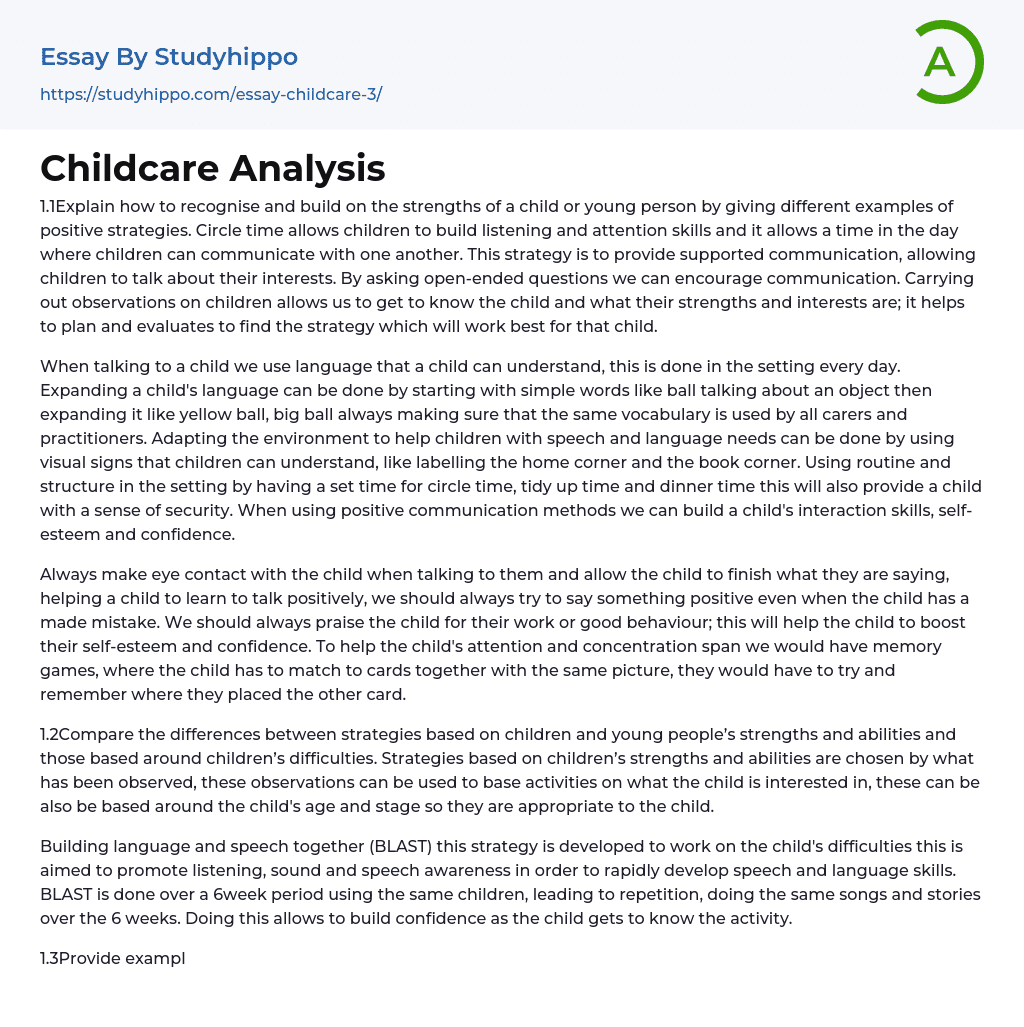1.1Explain how to recognise and build on the strengths of a child or young person by giving different examples of positive strategies. Circle time allows children to build listening and attention skills and it allows a time in the day where children can communicate with one another. This strategy is to provide supported communication, allowing children to talk about their interests. By asking open-ended questions we can encourage communication. Carrying out observations on children allows us to get to know the child and what their strengths and interests are; it helps to plan and evaluates to find the strategy which will work best for that child.
When talking to a child we use language that a child can understand, this is done in the setting every day. Expanding a child's lan
...guage can be done by starting with simple words like ball talking about an object then expanding it like yellow ball, big ball always making sure that the same vocabulary is used by all carers and practitioners. Adapting the environment to help children with speech and language needs can be done by using visual signs that children can understand, like labelling the home corner and the book corner. Using routine and structure in the setting by having a set time for circle time, tidy up time and dinner time this will also provide a child with a sense of security. When using positive communication methods we can build a child's interaction skills, self-esteem and confidence.
Always make eye contact with the child when talking to them and allow the child to finish what they are saying, helping a child to learn
to talk positively, we should always try to say something positive even when the child has a made mistake. We should always praise the child for their work or good behaviour; this will help the child to boost their self-esteem and confidence. To help the child's attention and concentration span we would have memory games, where the child has to match to cards together with the same picture, they would have to try and remember where they placed the other card.
1.2Compare the differences between strategies based on children and young people’s strengths and abilities and those based around children’s difficulties. Strategies based on children’s strengths and abilities are chosen by what has been observed, these observations can be used to base activities on what the child is interested in, these can be also be based around the child's age and stage so they are appropriate to the child.
Building language and speech together (BLAST) this strategy is developed to work on the child's difficulties this is aimed to promote listening, sound and speech awareness in order to rapidly develop speech and language skills. BLAST is done over a 6week period using the same children, leading to repetition, doing the same songs and stories over the 6 weeks. Doing this allows to build confidence as the child gets to know the activity.
1.3Provide examples of how current research evidence supports positive practice. The EYFS supports
2.1 Identify and describe the different strategies and targets that support children and young people’s speech, language and communication needs.
- Doll essays
- Public Speaking essays
- Freedom Of Speech essays
- Free Speech essays
- Persuasive Speech essays
- Gettysburg Address essays
- Informative Speech essays
- Child essays
- Child labor essays
- Childcare essays
- Ambition essays
- Anger essays
- Betrayal essays
- Boredom essays
- Confidence essays
- Courage essays
- Desire essays
- Disgrace essays
- Doubt essays
- Empathy essays
- Fairness essays
- Fear essays
- Feeling essays
- Forgiveness essays
- Grief essays
- Guilt essays
- Happiness essays
- Harmony essays
- Hate essays
- Honesty essays
- Honor essays
- Hope essays
- Humanity essays
- Inspiration essays
- Kindness essays
- Laughter essays
- Loneliness essays
- Lost essays
- Loyalty essays
- Need essays
- Passion essays
- Pressure essays
- Pride essays
- Regret essays
- Respect essays
- Responsibility essays
- Sarcasm essays
- Shame essays
- Suffering essays
- Suspense essays




